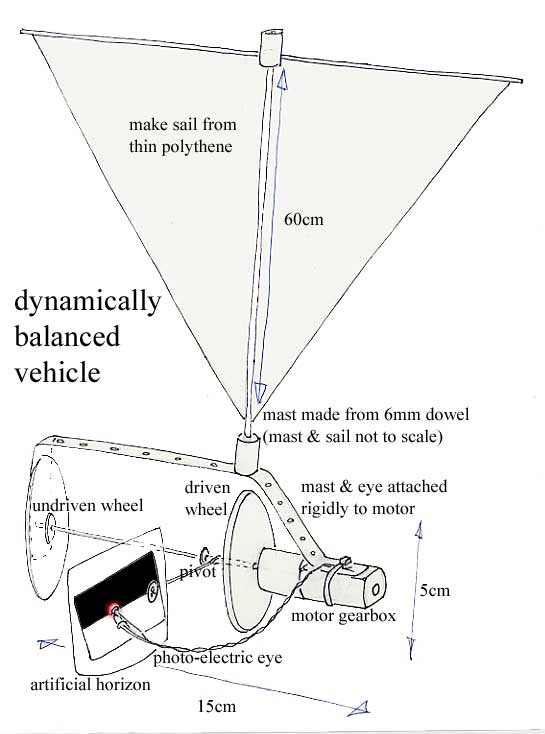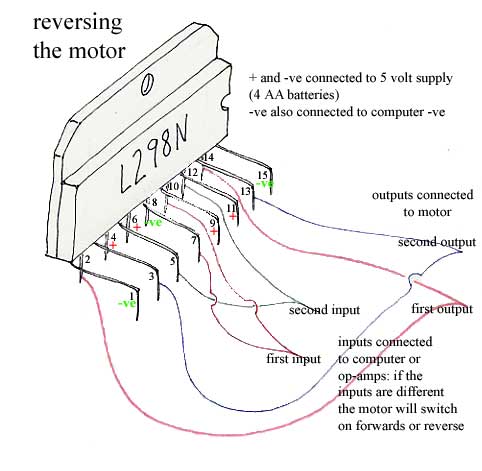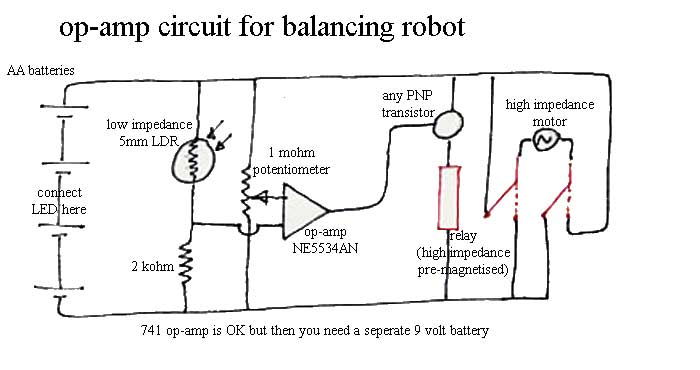dynamic balance
This is a dynamically balanced vehicle which is fairly easy to make


The only really exotic component is the motor/gearbox: it is a high impedance motor with a 62:1 epicyclic gearbox and cost £7. A cheaper option is to use a mabuchi solar motor without any gearbox at all, a walkman motor would also probably work although I haven't tried it. Use a wheel just slightly bigger than the motor body to maximise torque. One-wheel drive is important because the correcting force must be applied at the end of the dowel. If you use two wheel drive the sideways wobble of the mast puts all the weight on one wheel or the other and the vehicle spins about the axis of the mast. The undriven wheel provides sideways balance, like an outrigger, without exerting any steering force.
It will work without the sail and I have used up to 4ft of dowel successfully; the sail seems to increase the thinking time by a factor of about five, if you're going to write exotic control programs thinking time becomes an issue.
The artificial horizon is a piece of card half black half white bolted to another piece which rests on the ground like a skid, it is free to pivot round the axle with very little friction. Small adjustments can be made by rotating the black/white card.

The photo-electric eye is made of a toshiba high-brightness LED and a 5mm high impedance LDR looking at the spot of light created by the LED and sensing the change from white to black. This reverses the motor somehow, either with a relay or with a driver IC. The switching point should be as precise as possible, in practice this means either using an op-amp or a
pc printer port. The advantage of using a computer is that you can program in precise time delays to quantify the effect of any design changes and there is a lot of scope for moving on to more ambitious control methods.
You can put the batteries on the vehicle, the weight stops the wheel slipping. I have even put them at the top of the mast but this makes it work less well.
This is a movie of one without a mast, it has a lateral balance arm to provide fine adjustment. Coarse adjustment with the artificial horizon, fine adjustment with the balance arm.
This is an example of a
motor driver IC.

It cost about £3-50, it is a bit more difficult to use than a relay but works better in this application. It has two pairs of outputs which I have joined together in parallel. The current through them is controlled by pins 1 and 15 which I have shown connected straight to the minus, to slow one or either of the inputs down put a resistor between these pins and minus, about 5 ohms, the more the resistance the less the current from the output.
This is an op-amp circuit that works quite well just using 4 AA batteries

link to eveything there is to know on this subject
you tube movie of one that balances laterally as well
carnegie mellon ballbot
innovation versus vested interest
monowheels
liked the photo but didn't understand anything else
back to main site
my email is davidvwilliamson@hotmail.com




